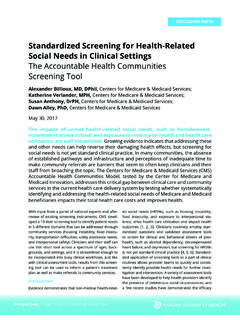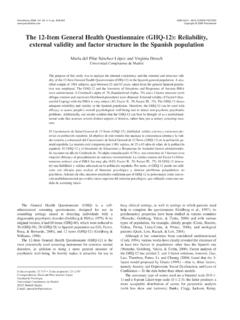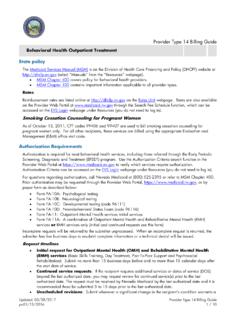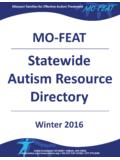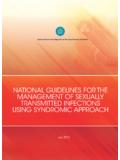Transcription of JOINT COMMITTEE ON INFANT HEARING
1 EXECUTIVE SUMMARY OF JOINT COMMITTEE ON INFANT HEARING YEAR 2007 POSITION STATEMENT Principles and Guidelines for Early HEARING Detection and Intervention Programs The JOINT COMMITTEE on INFANT HEARING (JCIH) endorses early detection of and intervention for infants with HEARING loss through integrated, interdisciplinary community, state, and federal systems of universal newborn HEARING screening, evaluation, and family-centered intervention. The goal of early HEARING detection and intervention (EHDI) is to maximize linguistic and communicative competence and literacy development for children who are deaf or hard of HEARING . Without appropriate opportunities to learn language, these children will fall behind their HEARING peers in language, cognition, and social-emotional development. Such delays may result in lower educational and employment levels in adulthood. PRINCIPLES All children with HEARING loss should have access to resources necessary to reach their maximum potential.
2 The following principles provide the foundation for effective EHDI systems and have been updated and expanded since the JCIH 2000 Position 1. All infants should have access to HEARING screening using a physiologic measure before 1 month of age. 2. All infants who do not pass the initial HEARING screen and the subsequent rescreening should have appropriate audiologic and medical evaluations to confirm the presence of HEARING loss before 3 months of age. 3. All infants with confirmed permanent HEARING loss should receive intervention 1 services before 6 months of age. A simplified, single point of entry into an intervention system appropriate to children with HEARING loss is optimal. 4. The EHDI system should be family centered with INFANT and family rights and privacy guaranteed through informed choice, shared decision making, and parental consent. Families should have access to information about all intervention and treatment options and counseling regarding HEARING loss.
3 5. The child and family should have immediate access to high-quality technology, including HEARING aids, cochlear implants, and other assistive devices when appropriate. 6. All infants and children should be monitored for HEARING loss in the medical home. Continued assessment of communication development should be provided by appropriate providers to all children with or without risk indicators for HEARING loss. 7. Appropriate interdisciplinary intervention programs for deaf and hard-of- HEARING infants and their families should be provided by professionals knowledgeable about childhood HEARING loss. Intervention programs should recognize and build on strengths, informed choices, traditions, and cultural beliefs of the families. 8. Information systems should be designed to interface with electronic health records and should be used to measure outcomes and report the effectiveness of EHDI services at the community, state, and federal levels.
4 JCIH 2007 POSITION STATEMENT SIGNIFICANT CHANGES The following are highlights of updates made since the JCIH 2000 statement1: 2 1. Definition of Targeted HEARING Loss The definition has been expanded from congenital permanent bilateral, unilateral sensory, or permanent conductive HEARING loss to include neural HEARING loss (eg, auditory neuropathy/dyssynchrony ) in infants admitted to the neonatal intensive care unit (NICU). 2. HEARING Screening and Rescreening Protocols Separate protocols are recommended for NICU and well-baby nurseries. NICU babies admitted for greater than 5 days are to have auditory brainstem response (ABR) included as part of their screening so that neural HEARING loss will not be missed. For infants who do not pass automated ABR in the NICU, referral should be made directly to an audiologist for rescreening and, when indicated, comprehensive evaluation including ABR. For rescreening, a complete screening on both ears is recommended, even if only one ear failed the initial screening.
5 For readmissions in the first month of life for all infants (NICU or well baby) when there are conditions associated with potential HEARING loss (eg, hyperbilirubinemia requiring exchange transfusion or culture-positive sepsis), a repeat HEARING screening is recommended before discharge. 3. Diagnostic Audiology Evaluation Audiologists with skills and expertise in evaluating newborn and young infants with HEARING loss should provide audiology diagnostic and auditory habilitation services (selection and fitting of amplification device). 3 At least one ABR test is recommended as part of a complete audiology diagnostic evaluation for children younger than 3 years for confirmation of permanent HEARING loss. The timing and number of HEARING re-evaluations for children with risk factors should be customized and individualized depending on the relative likelihood of a subsequent delayed-onset HEARING loss. Infants who pass the neonatal screening but have a risk factor should have at least 1 diagnostic audiology assessment by 24 to 30 months of age.
6 Early and more frequent assessment may be indicated for children with cytomegalovirus (CMV) infection, syndromes associated with progressive HEARING loss, neurodegenerative disorders, trauma, or culture-positive postnatal infections associated with sensorineural HEARING loss; for children who have received ECMO or chemotherapy; and when there is caregiver concern or a family history of HEARING loss. For families who elect amplification, infants in whom permanent HEARING loss is diagnosed should be fitted with an amplification device within 1 month of diagnosis. 4. Medical Evaluation For infants with confirmed HEARING loss, a genetics consultation should be offered to their families. Every INFANT with confirmed HEARING loss should be evaluated by an otolaryngologist with knowledge of pediatric HEARING loss and have at least 1 examination to assess visual acuity by an ophthalmologist experienced in evaluating infants.
7 The risk factors for congenital and acquired HEARING loss have been combined in a single list, rather than grouped by time of onset. 5. Early Intervention 4 All families of infants with any degree of bilateral or unilateral permanent HEARING loss should be considered eligible for early intervention services. There should be recognized central referral points of entry that ensure specialty services for infants with confirmed HEARING loss. Early intervention services for infants with confirmed HEARING loss should be provided by professionals with expertise in HEARING loss, including educators of the deaf, speech-language pathologists, and audiologists. In response to a previous emphasis on natural environments, the COMMITTEE recommends that both home-based and center-based intervention options should be offered. 6. Surveillance and Screening in the Medical Home For all infants, regular surveillance of developmental milestones, auditory skills, parental concerns, and middle ear status should be performed in the medical home, consistent with the American Academy of Pediatrics (AAP) pediatric periodicity schedule.
8 All infants should have an objective standardized screening of global development with a validated assessment tool at 9, 18, and 24 to 30 months of age or at any time if the health care professional or family has concern. Infants who do not pass the speech-language portion of a medical home global screening or for whom there is a concern regarding HEARING or language should be referred for speech-language evaluation and audiology assessment. 7. Communication The birth hospital, in collaboration with the state EHDI coordinator, should ensure that the HEARING screening results are conveyed to the parents and the medical home. 5 Parents should be provided with appropriate follow-up and resource information, and hospitals should ensure that each INFANT is linked to a medical home. Information at all stages of the EHDI process is to be communicated to the family in a culturally sensitive and understandable format.
9 Individual HEARING screening information and audiology diagnostic and habilitation information should be promptly transmitted to the medical home and the state EHDI coordinator. Families should be made aware of all communication options and available HEARING technologies (presented in an unbiased manner). Informed family choice and desired outcome guide the decision-making process. 8. Information Infrastructure States should implement data-management and tracking systems as part of an integrated child health information system to monitor the quality of EHDI services and provide recommendations for improving systems of care. An effective link between health and education professionals is needed to ensure successful transition and to determine outcomes of children with HEARING loss for planning and establishing public health policy. CURRENT CHALLENGES, OPPORTUNITIES, AND FUTURE DIRECTIONS EHDI programs throughout the nation have demonstrated not only the feasibility of universal newborn HEARING screening (UNHS) but also the benefits of early identification and intervention.
10 There is a growing body of literature indicating that when identification and intervention occur no later than 6 months of age for newborn infants who are deaf or hard of HEARING , the infants perform as much as 20 to 40 percentile points higher on school-related measures (vocabulary, 6 articulation, intelligibility, social adjustment, and behavior). Still, many important challenges remain. Despite the fact that approximately 95% of newborn infants have their HEARING screened in the United States, almost half of newborn infants who do not pass the initial screening fail to have appropriate follow-up to either confirm the presence of a HEARING loss and/or initiate appropriate early intervention services Despite the tremendous progress made since 2000, there are many challenges important to the further development of successful EHDI systems. Many of these challenges, opportunities for system development, and areas for research are outlined in the complete document.
